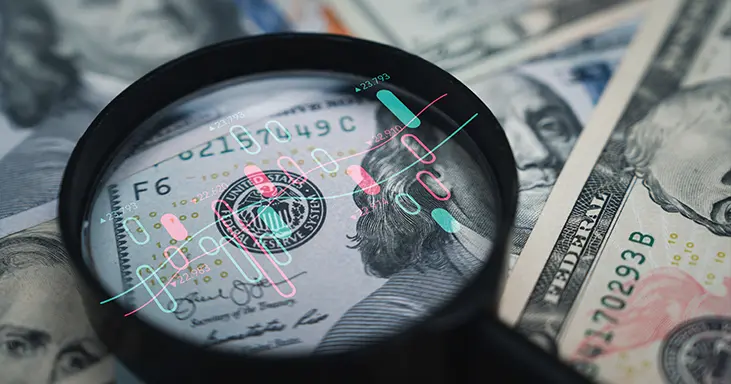


Understanding Currency Strength and Weakness
Forex Fundamentals
Introduction: Unraveling the Dynamics of Currency Strength
Currency strength isn't just a metric; it's a vivid story of economic prowess and market sentiment that unfolds in the Forex markets daily. This measure of relative power—how one currency stands against another—dictates not only the flow of global trade but also the strategies of Forex traders worldwide.
This article delves deep into understanding currency strengths and
weaknesses, exploring its underpinnings through economic indicators, political stability, and market dynamics. By dissecting the forces that drive currency
values, from GDP and inflation rates to foreign investment flows, we equip you
with the knowledge to interpret these financial tides. Whether you're a
seasoned trader or a curious observer, this guide promises.
Understanding Currency Strength
What is Currency Strength?
Currency strength is the backbone of Forex trading, acting as a barometer for the relative value of currencies globally. It tells us how strong one currency is compared to another within the bustling foreign exchange markets.
Imagine walking into a bustling market where each stall represents a country's currency; some stalls are crowded, indicating strong demand, while others are quieter, showing lesser value. This scenario paints a picture of currency strength at its core.
Tools to Measure Currency Strength
Traders and economists use tools like the Currency Strength Meter to navigate these complex financial waters. This handy device lets you glance at currencies' robustness, helping you make informed decisions in real-time.
It's akin to having a weather radar that predicts financial storms or sunny days, ensuring you're equipped to handle whatever the Forex markets throw your way.
The Role of Currency Strength in Forex
Understanding currency strength is crucial for traders and anyone involved in global economic activities. It influences everything from the price you pay for imported goods to the returns on your investments abroad. For example, if the U.S. Dollar strengthens against the Euro, your European vacation might suddenly become more affordable.
This dynamic concept relies heavily on various economic indicators such as GDP, inflation rates, and nations' overall economic health. By keeping a pulse on these factors, one can anticipate movements in currency strength, turning the unpredictable Forex markets into a navigable map of potential opportunities and risks.
In this section, we'll explore these mechanisms in detail, giving you a clear view of how currency strength is calculated and how it impacts the global economic landscape. This knowledge is not just for traders but anyone interested in the economic forces shaping our world.
Economic Indicators: The Pillars of Currency Valuation
Currency strength is intricately linked to a country's economic health, and certain indicators act like the vital signs of this health. For instance, a robust Gross Domestic Product (GDP) suggests a thriving economy, often strengthening the currency. Similarly, low inflation rates can enhance a currency's appeal by indicating stable prices, making the currency a safer store of value. Conversely, high inflation can erode purchasing power and weaken a currency.
Political Stability: The Role of Governance
The stability of a country's government also plays a critical role in determining currency strength. Political unrest can lead to economic uncertainty, often resulting in currency depreciation.
On the other hand, a stable and predictable government can boost investor confidence and, consequently, the currency's value. Consider how the British pound tends to react to unexpected political events, such as elections or Brexit negotiations; these events can trigger swift fluctuations in the pound's strength against other major currencies.
Global Trade and Investment Flows
The flow of foreign investment is a major determinant of currency strength. Countries that attract foreign direct investment (FDI) benefit from the inflow of foreign currencies, which can strengthen their domestic currencies. For example, when a multinational corporation invests in a factory in a developing country, it often needs to convert its funds into the local currency, increasing demand for that currency and potentially boosting its value.
Moreover, a country's trade balance—whether it exports more than imports—can significantly influence its currency's strength. A positive trade balance, or a surplus, implies that more foreign customers are buying a country's exports, hence buying its currency through trade, leading to the strengthening of the currency.
Each of these factors—economic indicators, political stability, and global trade dynamics—plays a crucial role in the ever-changing landscape of Forex markets. By understanding these factors, traders and economists can better predict which currencies will strengthen and which will weaken, thereby navigating the complex world of currency trading with greater confidence and strategic insight.
Boosting International Buying Power
A strong currency enhances a nation's buying power on the international stage, making imports more affordable and reducing the cost of foreign debts. With a robust U.S. dollar, American companies and consumers can purchase more goods and services from abroad for the same amount of money, effectively stretching the dollar further on the global market. This scenario leads to lower import costs and can contribute to low inflation rates within the home country.
Economic Drawbacks of a Strong Currency
However, not all effects of currency strength are beneficial. A strong currency can be a double-edged sword for countries heavily reliant on exports. It makes their goods more expensive and less attractive in foreign markets, potentially reducing export volumes.
Imagine a scenario where French wines
become significantly more expensive abroad due to a strong euro; international
buyers might opt for cheaper alternatives from other countries, impacting
France's wine industry and trade balance.
The Flip Side: Weak Currency Woes
On the flip side, while potentially boosting export competitiveness by making products cheaper on the international market, a weak currency also has its pitfalls. It can increase the cost of imports and contribute to domestic inflation, as seen in countries with depreciating currencies. For instance, if the Indian rupee weakens significantly against the dollar, the cost of oil, which is priced in dollars, rises in rupee terms, leading to higher overall prices and inflation within India.
A Balanced View
Ultimately, the impact of currency strength on an economy is a balancing act. While a strong currency may be ideal for an import-heavy nation, it can pose challenges for export-driven economies. Conversely, a weaker currency might help exporters but hurt consumers by making imports pricier and fueling inflation.
Understanding these dynamics is crucial for policymakers, businesses, and investors who navigate these waters daily, striving to harness currency movements to their advantage. Each scenario demands a nuanced approach to maximize benefits and mitigate risks associated with currency fluctuations.
Trading with Currency Strength. Harnessing Currency Strength for Strategic Advantage
Trading with currency strength is a tactical approach in Forex trading that hinges on recognizing and capitalizing on the strength or weakness of global currencies. Imagine a chess game where each move is a trade decision based on the strength of a currency.
Traders use this strategy to align themselves with the prevailing financial currents, ensuring they always swim with the tide, not against it.
Tools of the Trade: Currency Strength Meters
A key tool in this strategy is the currency strength meter, which provides a real-time visual representation of the strengths or weaknesses of major currencies. This tool is like a weather vane, showing how the economic winds are blowing, allowing traders to adjust their positions accordingly.
Using a currency strength meter, traders can avoid potential losses from unfavorable currency movements and spot opportunities where a currency's strength or weakness is just beginning to surface.
Real-Time Decisions and Risk Mitigation
Effective currency strength trading involves more than knowing a currency's current state; it requires understanding how to anticipate shifts and protect against volatility. For instance, if a currency strength meter indicates that the Euro is gaining strength against the Yen, a trader might consider buying EUR/JPY before the trend becomes common knowledge and the opportunity dissipates.
Additionally, traders might use this tool to hedge their bets, pairing strong currencies against weak ones to mitigate risk and capitalize on the differential.
The Strategic Edge
Using currency strength to guide trading decisions allows for a more measured, strategic approach to Forex. It enables traders to make informed decisions based on a comprehensive analysis of market dynamics rather than reacting to market noise. This method not only enhances the profit potential but also significantly reduces exposure to risk, providing a clear edge in the competitive world of currency trading.
By integrating currency strength into their trading strategies, Forex traders can navigate the market more confidently and precisely, turning currency fluctuations into profitable opportunities. Whether you're a novice learning the ropes or a seasoned trader refining your strategy, understanding and utilizing currency strength can profoundly influence your trading outcomes.
Real-World Examples of Currency Strength and Weakness. Spotlight on the Forex Stage
The currency strength and weakness dynamics play out dramatically on the global stage, influencing international trade, investment, and economic policy. Consider the impact of the U.S. dollar's strength on emerging markets. A strong dollar can lead to capital outflows from emerging economies as investors seek higher returns in the U.S., weakening local currencies and potentially destabilizing these economies.
The Euro and Brexit
A quintessential example of currency fluctuations is observed in the Euro's response to political events like Brexit. The uncertainty surrounding the U.K.'s decision to leave the EU led to volatile swings in the Euro, impacting trade agreements, investment flows, and economic forecasts across Europe.
The Asian Market Response
In Asia, the Japanese Yen often acts as a safe haven during global financial uncertainty. During economic stress, such as the 2008 financial crisis, traders and investors flocked to the Yen, strengthening it significantly against other currencies and impacting Japan's export-driven economy by making its products more expensive abroad.
These real-world scenarios underline the profound effect currency strength and weakness can have on the countries directly involved and the global economic landscape. Understanding these trends allows traders, businesses, and policymakers to make more informed decisions, steering through the volatile waters of international finance.
FAQs on Currency Strength and Weakness
What is a currency strength meter?
A currency strength meter is a tool traders use to gauge the relative strength of different currencies in the Forex market. It helps identify which currencies are strong and which are weak at any given moment, aiding in decision-making for buying or selling currency pairs.
How does currency strength affect imports and exports?
Currency strength directly influences a country's trade balance. A stronger currency makes imports cheaper and exports more expensive, while a weaker currency does the opposite, boosting export competitiveness but making imports costlier.
Can a strong currency be detrimental?
Yes, while a strong currency lowers import costs and can reduce inflation, it may also harm export-driven sectors by making products pricier and less attractive in global markets.



